NISSAN ALMERA 2001 Manual PDF
Manufacturer: NISSAN, Model Year: 2001, Model line: ALMERA, Model: NISSAN ALMERA 2001Pages: 2898, PDF Size: 60.76 MB
Page 71 of 2898
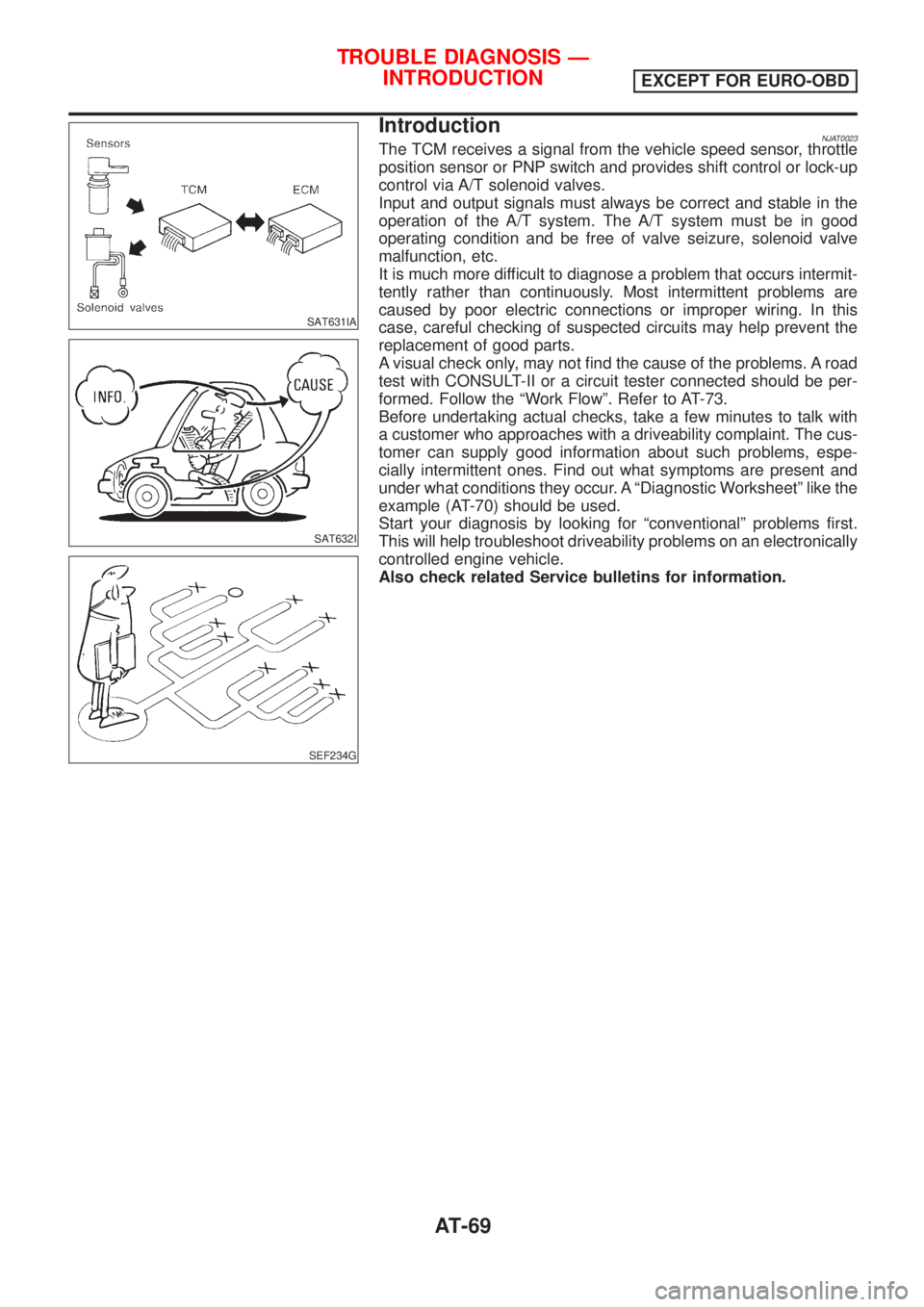
SAT631IA
SAT632I
SEF234G
IntroductionNJAT0023The TCM receives a signal from the vehicle speed sensor, throttle
position sensor or PNP switch and provides shift control or lock-up
control via A/T solenoid valves.
Input and output signals must always be correct and stable in the
operation of the A/T system. The A/T system must be in good
operating condition and be free of valve seizure, solenoid valve
malfunction, etc.
It is much more difficult to diagnose a problem that occurs intermit-
tently rather than continuously. Most intermittent problems are
caused by poor electric connections or improper wiring. In this
case, careful checking of suspected circuits may help prevent the
replacement of good parts.
A visual check only, may not find the cause of the problems. A road
test with CONSULT-II or a circuit tester connected should be per-
formed. Follow the ªWork Flowº. Refer to AT-73.
Before undertaking actual checks, take a few minutes to talk with
a customer who approaches with a driveability complaint. The cus-
tomer can supply good information about such problems, espe-
cially intermittent ones. Find out what symptoms are present and
under what conditions they occur. A ªDiagnostic Worksheetº like the
example (AT-70) should be used.
Start your diagnosis by looking for ªconventionalº problems first.
This will help troubleshoot driveability problems on an electronically
controlled engine vehicle.
Also check related Service bulletins for information.
TROUBLE DIAGNOSIS Ð
INTRODUCTION
EXCEPT FOR EURO-OBD
AT-69
Page 72 of 2898
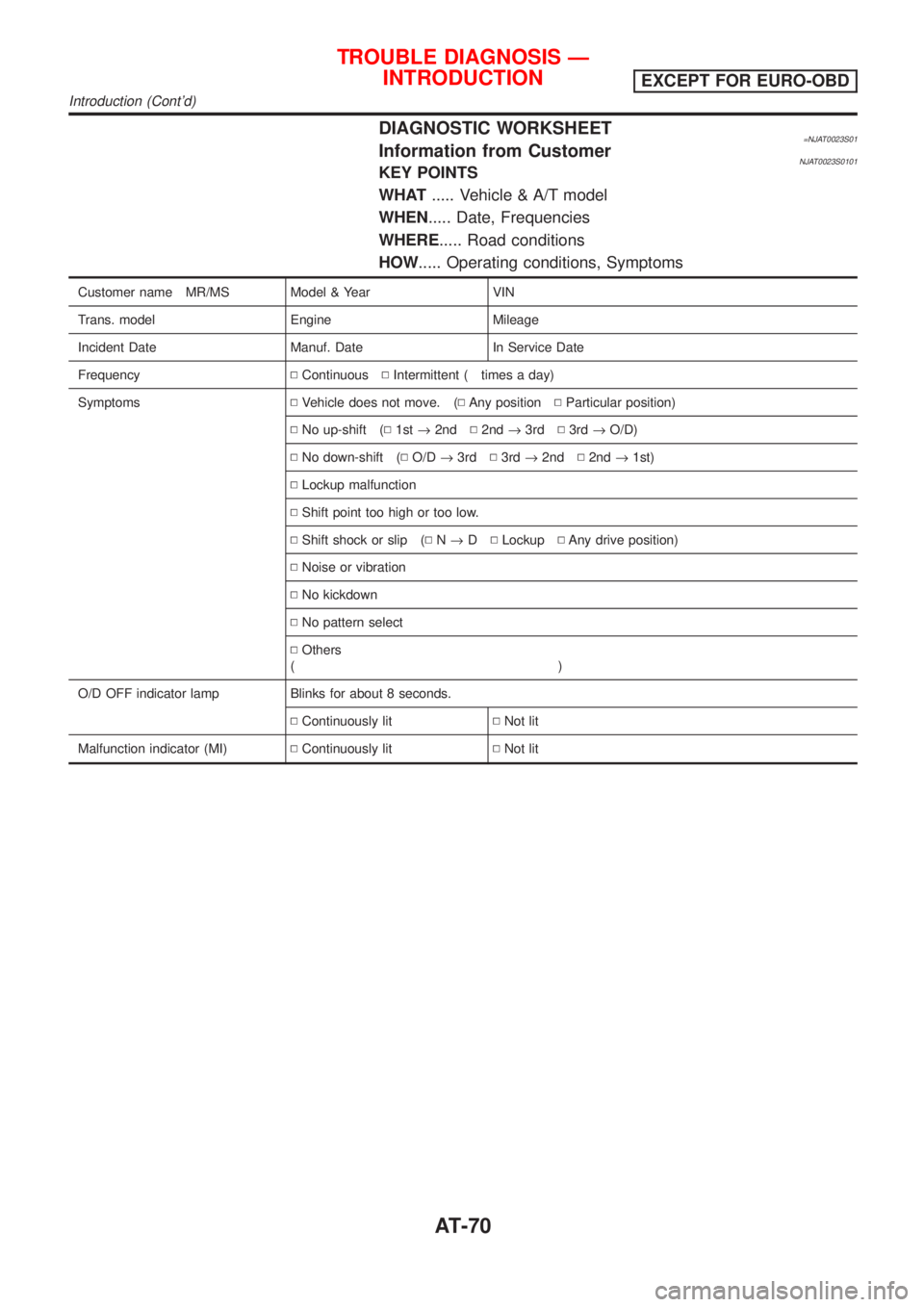
DIAGNOSTIC WORKSHEET=NJAT0023S01Information from CustomerNJAT0023S0101KEY POINTS
WHAT..... Vehicle & A/T model
WHEN..... Date, Frequencies
WHERE..... Road conditions
HOW..... Operating conditions, Symptoms
Customer name MR/MS Model & Year VIN
Trans. model Engine Mileage
Incident Date Manuf. Date In Service Date
FrequencyNContinuousNIntermittent ( times a day)
SymptomsNVehicle does not move. (NAny positionNParticular position)
NNo up-shift (N1st®2ndN2nd®3rdN3rd®O/D)
NNo down-shift (NO/D®3rdN3rd®2ndN2nd®1st)
NLockup malfunction
NShift point too high or too low.
NShift shock or slip (NN®DNLockupNAny drive position)
NNoise or vibration
NNo kickdown
NNo pattern select
NOthers
()
O/D OFF indicator lamp Blinks for about 8 seconds.
NContinuously litNNot lit
Malfunction indicator (MI)NContinuously litNNot lit
TROUBLE DIAGNOSIS Ð
INTRODUCTION
EXCEPT FOR EURO-OBD
Introduction (Cont'd)
AT-70
Page 73 of 2898
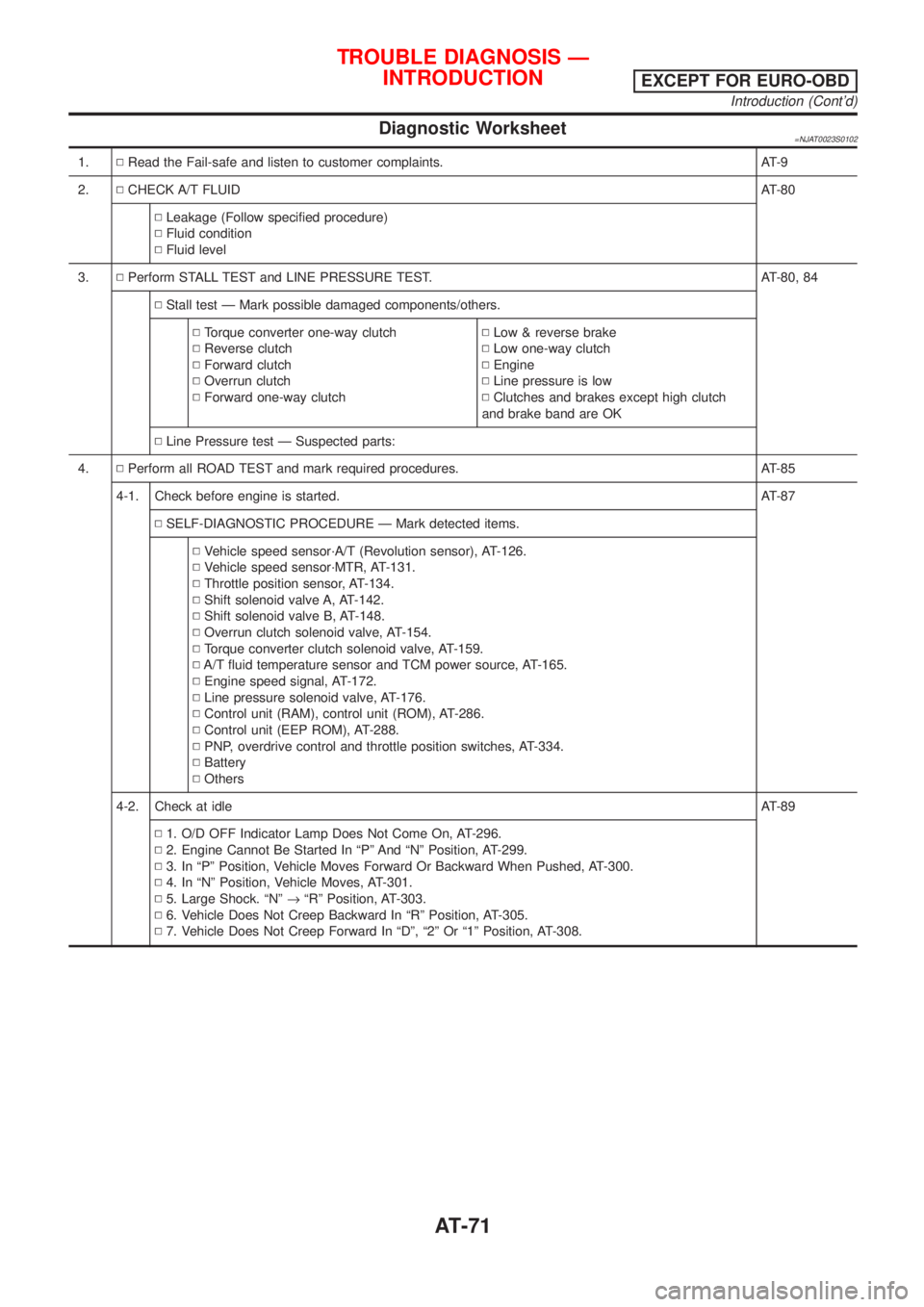
Diagnostic Worksheet=NJAT0023S0102
1.NRead the Fail-safe and listen to customer complaints. AT-9
2.NCHECK A/T FLUIDAT-80
NLeakage (Follow specified procedure)
NFluid condition
NFluid level
3.NPerform STALL TEST and LINE PRESSURE TEST. AT-80, 84
NStall test Ð Mark possible damaged components/others.
NTorque converter one-way clutch
NReverse clutch
NForward clutch
NOverrun clutch
NForward one-way clutchNLow & reverse brake
NLow one-way clutch
NEngine
NLine pressure is low
NClutches and brakes except high clutch
and brake band are OK
NLine Pressure test Ð Suspected parts:
4.NPerform all ROAD TEST and mark required procedures. AT-85
4-1. Check before engine is started. AT-87
NSELF-DIAGNOSTIC PROCEDURE Ð Mark detected items.
NVehicle speed sensor´A/T (Revolution sensor), AT-126.
NVehicle speed sensor´MTR, AT-131.
NThrottle position sensor, AT-134.
NShift solenoid valve A, AT-142.
NShift solenoid valve B, AT-148.
NOverrun clutch solenoid valve, AT-154.
NTorque converter clutch solenoid valve, AT-159.
NA/T fluid temperature sensor and TCM power source, AT-165.
NEngine speed signal, AT-172.
NLine pressure solenoid valve, AT-176.
NControl unit (RAM), control unit (ROM), AT-286.
NControl unit (EEP ROM), AT-288.
NPNP, overdrive control and throttle position switches, AT-334.
NBattery
NOthers
4-2. Check at idleAT-89
N1. O/D OFF Indicator Lamp Does Not Come On, AT-296.
N2. Engine Cannot Be Started In ªPº And ªNº Position, AT-299.
N3. In ªPº Position, Vehicle Moves Forward Or Backward When Pushed, AT-300.
N4. In ªNº Position, Vehicle Moves, AT-301.
N5. Large Shock. ªNº®ªRº Position, AT-303.
N6. Vehicle Does Not Creep Backward In ªRº Position, AT-305.
N7. Vehicle Does Not Creep Forward In ªDº, ª2º Or ª1º Position, AT-308.
TROUBLE DIAGNOSIS Ð
INTRODUCTION
EXCEPT FOR EURO-OBD
Introduction (Cont'd)
AT-71
Page 74 of 2898
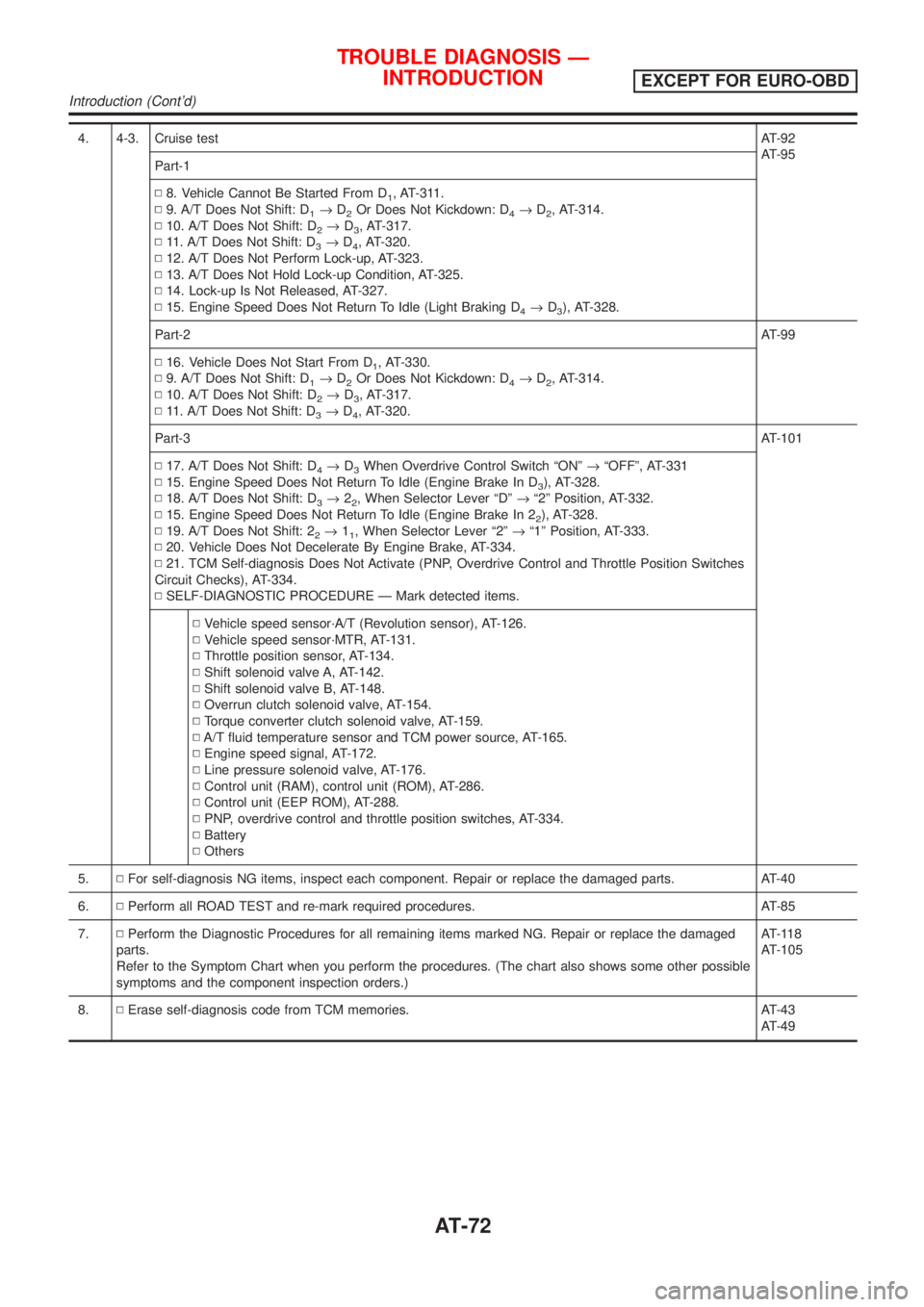
4. 4-3. Cruise testAT-92
AT-95
Part-1
N8. Vehicle Cannot Be Started From D
1, AT-311.
N9. A/T Does Not Shift: D
1®D2Or Does Not Kickdown: D4®D2, AT-314.
N10. A/T Does Not Shift: D
2®D3, AT-317.
N11. A/T Does Not Shift: D
3®D4, AT-320.
N12. A/T Does Not Perform Lock-up, AT-323.
N13. A/T Does Not Hold Lock-up Condition, AT-325.
N14. Lock-up Is Not Released, AT-327.
N15. Engine Speed Does Not Return To Idle (Light Braking D
4®D3), AT-328.
Part-2AT-99
N16. Vehicle Does Not Start From D
1, AT-330.
N9. A/T Does Not Shift: D
1®D2Or Does Not Kickdown: D4®D2, AT-314.
N10. A/T Does Not Shift: D
2®D3, AT-317.
N11. A/T Does Not Shift: D
3®D4, AT-320.
Part-3AT-101
N17. A/T Does Not Shift: D
4®D3When Overdrive Control Switch ªONº®ªOFFº, AT-331
N15. Engine Speed Does Not Return To Idle (Engine Brake In D
3), AT-328.
N18. A/T Does Not Shift: D
3®22, When Selector Lever ªDº®ª2º Position, AT-332.
N15. Engine Speed Does Not Return To Idle (Engine Brake In 2
2), AT-328.
N19. A/T Does Not Shift: 2
2®11, When Selector Lever ª2º®ª1º Position, AT-333.
N20. Vehicle Does Not Decelerate By Engine Brake, AT-334.
N21. TCM Self-diagnosis Does Not Activate (PNP, Overdrive Control and Throttle Position Switches
Circuit Checks), AT-334.
NSELF-DIAGNOSTIC PROCEDURE Ð Mark detected items.
NVehicle speed sensor´A/T (Revolution sensor), AT-126.
NVehicle speed sensor´MTR, AT-131.
NThrottle position sensor, AT-134.
NShift solenoid valve A, AT-142.
NShift solenoid valve B, AT-148.
NOverrun clutch solenoid valve, AT-154.
NTorque converter clutch solenoid valve, AT-159.
NA/T fluid temperature sensor and TCM power source, AT-165.
NEngine speed signal, AT-172.
NLine pressure solenoid valve, AT-176.
NControl unit (RAM), control unit (ROM), AT-286.
NControl unit (EEP ROM), AT-288.
NPNP, overdrive control and throttle position switches, AT-334.
NBattery
NOthers
5.NFor self-diagnosis NG items, inspect each component. Repair or replace the damaged parts. AT-40
6.NPerform all ROAD TEST and re-mark required procedures. AT-85
7.NPerform the Diagnostic Procedures for all remaining items marked NG. Repair or replace the damaged
parts.
Refer to the Symptom Chart when you perform the procedures. (The chart also shows some other possible
symptoms and the component inspection orders.)AT-118
AT-105
8.NErase self-diagnosis code from TCM memories. AT-43
AT-49
TROUBLE DIAGNOSIS Ð
INTRODUCTION
EXCEPT FOR EURO-OBD
Introduction (Cont'd)
AT-72
Page 75 of 2898
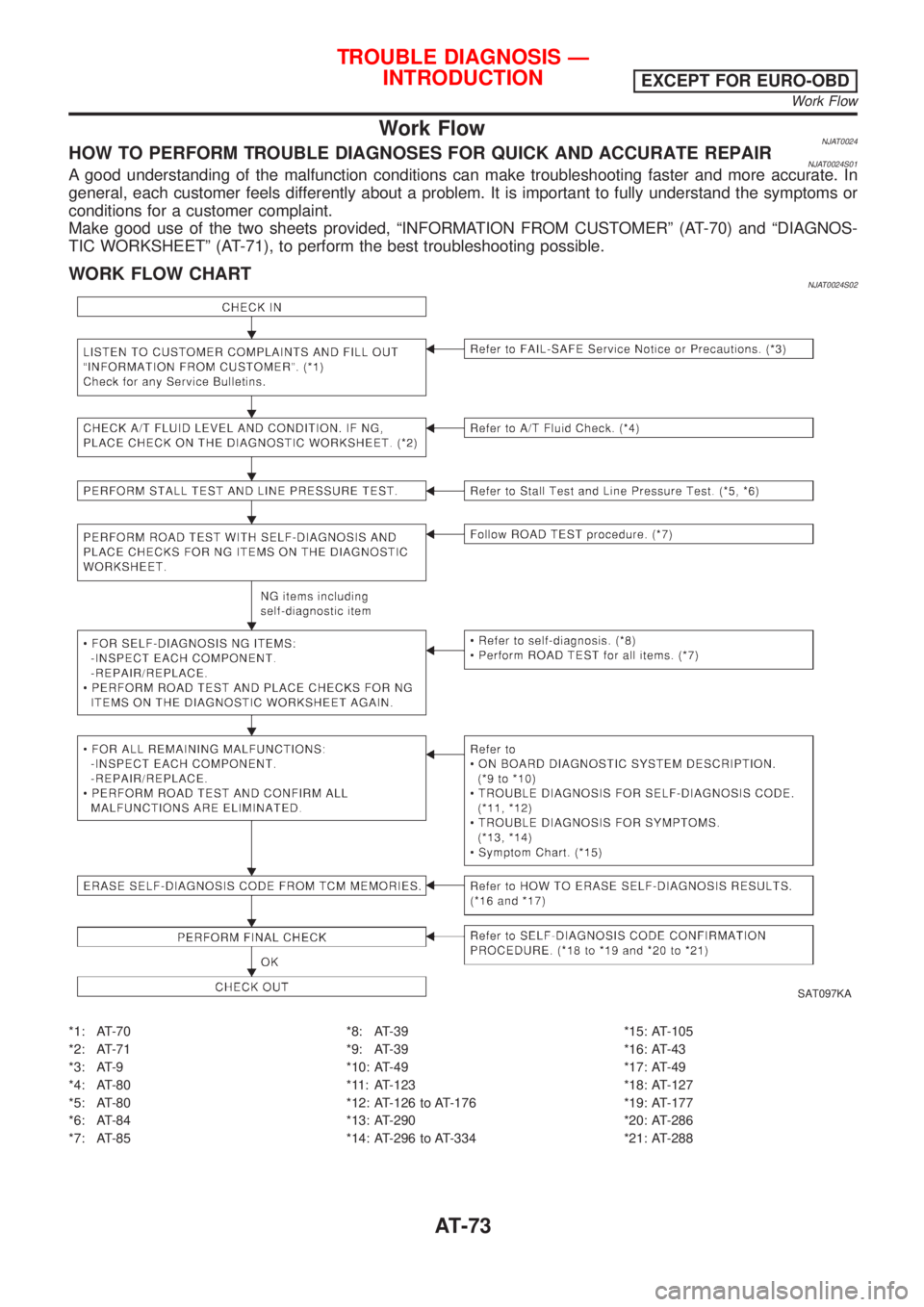
Work FlowNJAT0024HOW TO PERFORM TROUBLE DIAGNOSES FOR QUICK AND ACCURATE REPAIRNJAT0024S01A good understanding of the malfunction conditions can make troubleshooting faster and more accurate. In
general, each customer feels differently about a problem. It is important to fully understand the symptoms or
conditions for a customer complaint.
Make good use of the two sheets provided, ªINFORMATION FROM CUSTOMERº (AT-70) and ªDIAGNOS-
TIC WORKSHEETº (AT-71), to perform the best troubleshooting possible.
WORK FLOW CHARTNJAT0024S02
SAT097KA
*1: AT-70
*2: AT-71
*3: AT-9
*4: AT-80
*5: AT-80
*6: AT-84
*7: AT-85*8: AT-39
*9: AT-39
*10: AT-49
*11: AT-123
*12: AT-126 to AT-176
*13: AT-290
*14: AT-296 to AT-334*15: AT-105
*16: AT-43
*17: AT-49
*18: AT-127
*19: AT-177
*20: AT-286
*21: AT-288
TROUBLE DIAGNOSIS Ð
INTRODUCTION
EXCEPT FOR EURO-OBD
Work Flow
AT-73
Page 76 of 2898
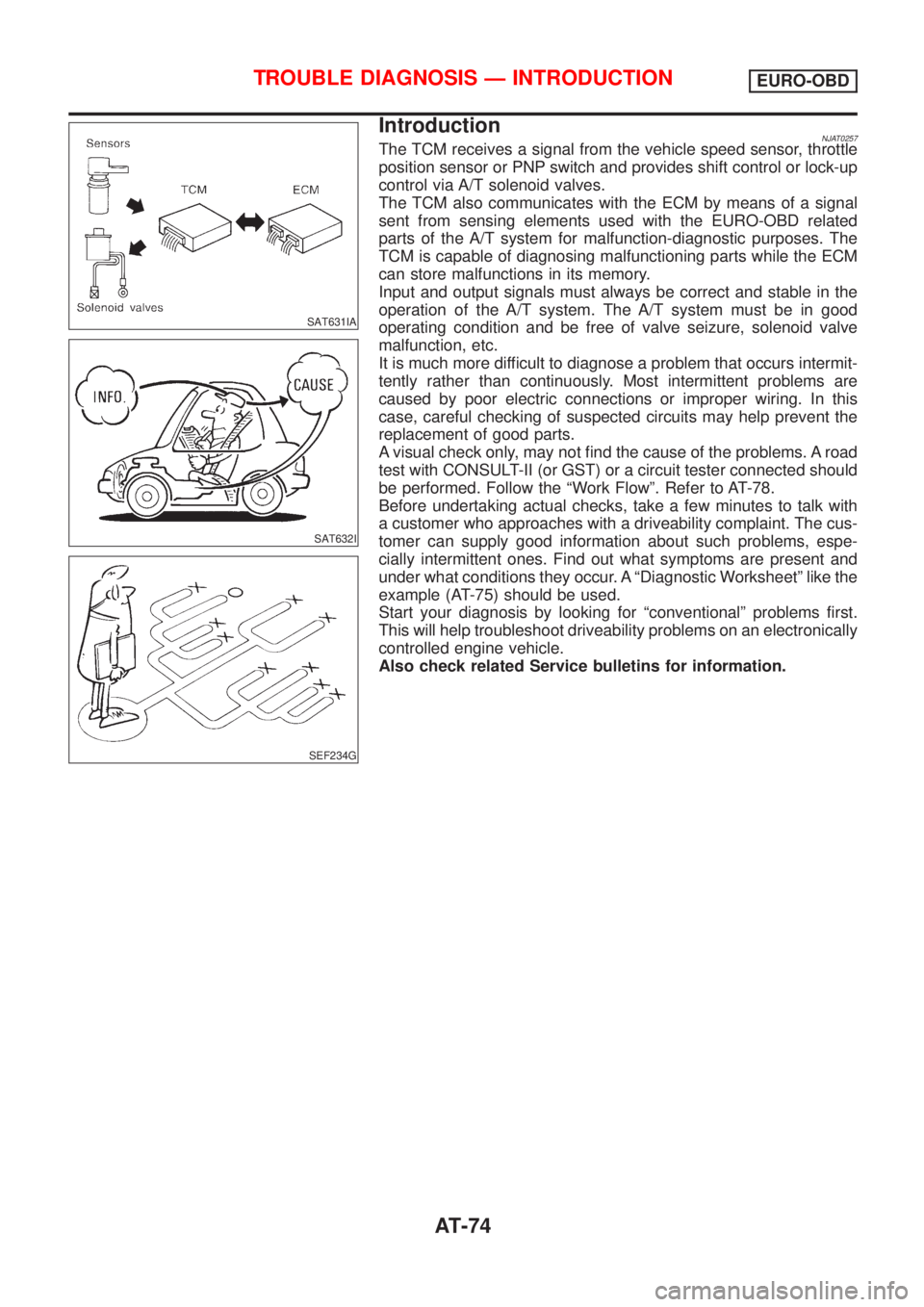
SAT631IA
SAT632I
SEF234G
IntroductionNJAT0257The TCM receives a signal from the vehicle speed sensor, throttle
position sensor or PNP switch and provides shift control or lock-up
control via A/T solenoid valves.
The TCM also communicates with the ECM by means of a signal
sent from sensing elements used with the EURO-OBD related
parts of the A/T system for malfunction-diagnostic purposes. The
TCM is capable of diagnosing malfunctioning parts while the ECM
can store malfunctions in its memory.
Input and output signals must always be correct and stable in the
operation of the A/T system. The A/T system must be in good
operating condition and be free of valve seizure, solenoid valve
malfunction, etc.
It is much more difficult to diagnose a problem that occurs intermit-
tently rather than continuously. Most intermittent problems are
caused by poor electric connections or improper wiring. In this
case, careful checking of suspected circuits may help prevent the
replacement of good parts.
A visual check only, may not find the cause of the problems. A road
test with CONSULT-II (or GST) or a circuit tester connected should
be performed. Follow the ªWork Flowº. Refer to AT-78.
Before undertaking actual checks, take a few minutes to talk with
a customer who approaches with a driveability complaint. The cus-
tomer can supply good information about such problems, espe-
cially intermittent ones. Find out what symptoms are present and
under what conditions they occur. A ªDiagnostic Worksheetº like the
example (AT-75) should be used.
Start your diagnosis by looking for ªconventionalº problems first.
This will help troubleshoot driveability problems on an electronically
controlled engine vehicle.
Also check related Service bulletins for information.
TROUBLE DIAGNOSIS Ð INTRODUCTIONEURO-OBD
AT-74
Page 77 of 2898
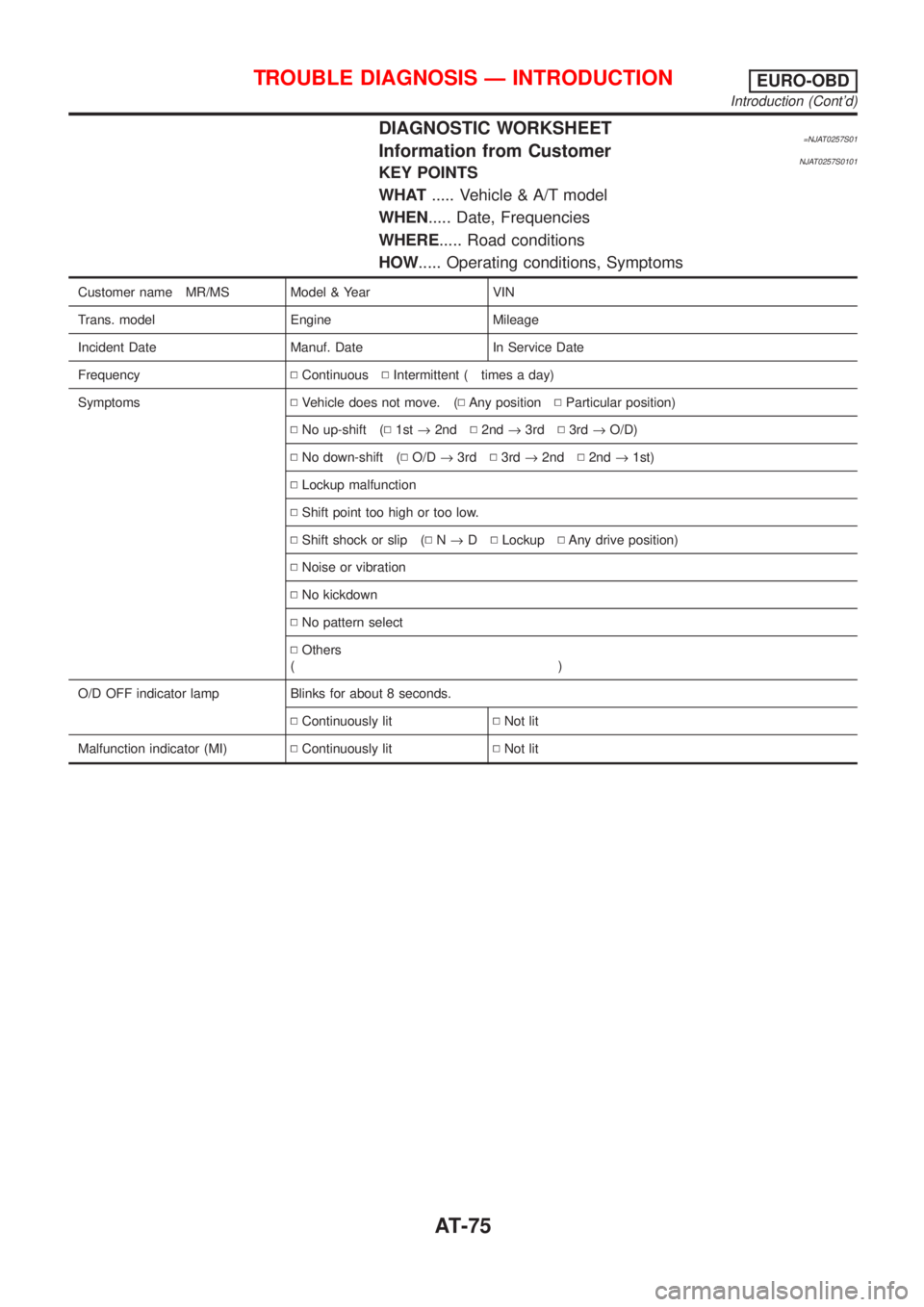
DIAGNOSTIC WORKSHEET=NJAT0257S01Information from CustomerNJAT0257S0101KEY POINTS
WHAT..... Vehicle & A/T model
WHEN..... Date, Frequencies
WHERE..... Road conditions
HOW..... Operating conditions, Symptoms
Customer name MR/MS Model & Year VIN
Trans. model Engine Mileage
Incident Date Manuf. Date In Service Date
FrequencyNContinuousNIntermittent ( times a day)
SymptomsNVehicle does not move. (NAny positionNParticular position)
NNo up-shift (N1st®2ndN2nd®3rdN3rd®O/D)
NNo down-shift (NO/D®3rdN3rd®2ndN2nd®1st)
NLockup malfunction
NShift point too high or too low.
NShift shock or slip (NN®DNLockupNAny drive position)
NNoise or vibration
NNo kickdown
NNo pattern select
NOthers
()
O/D OFF indicator lamp Blinks for about 8 seconds.
NContinuously litNNot lit
Malfunction indicator (MI)NContinuously litNNot lit
TROUBLE DIAGNOSIS Ð INTRODUCTIONEURO-OBD
Introduction (Cont'd)
AT-75
Page 78 of 2898
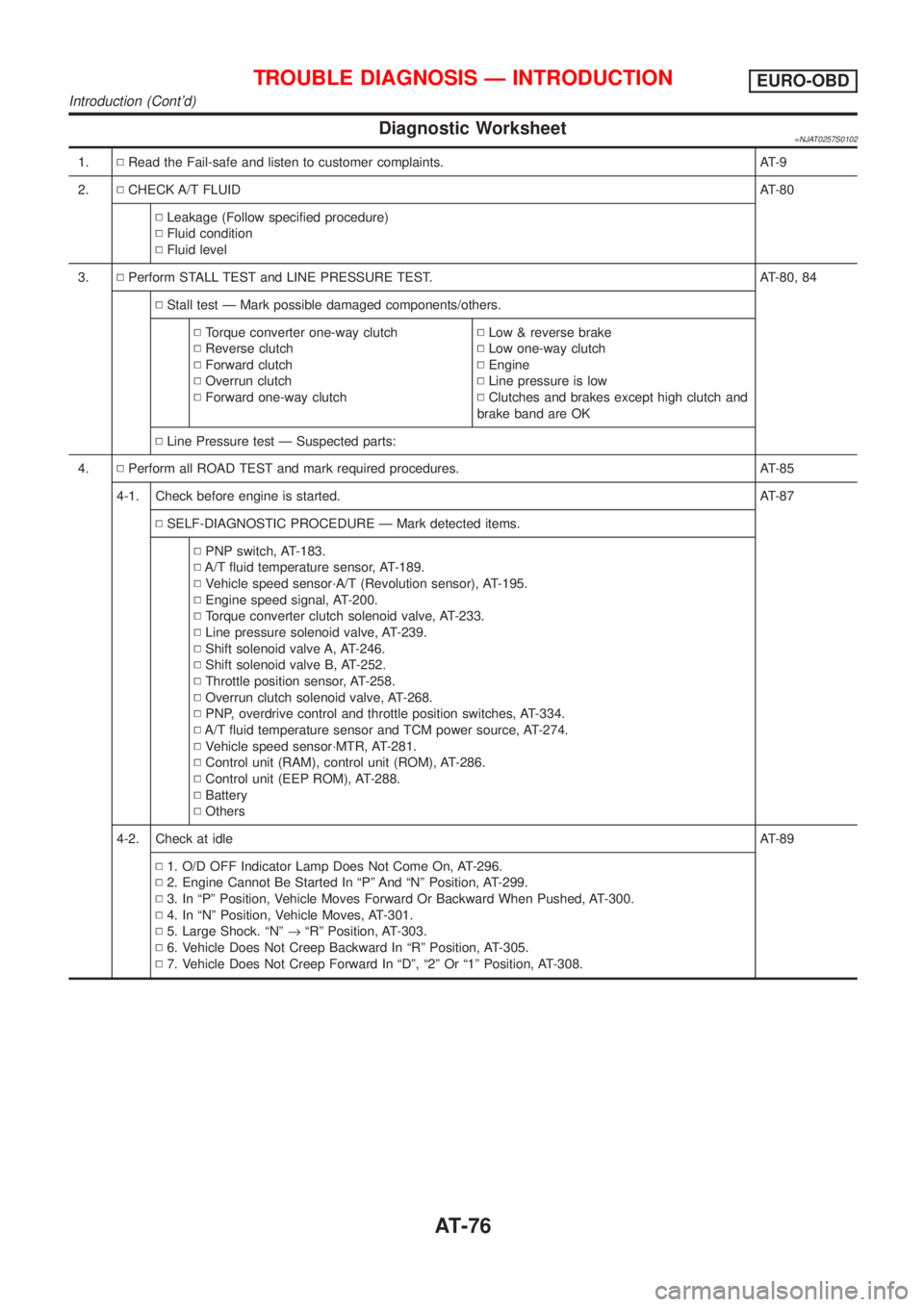
Diagnostic Worksheet=NJAT0257S0102
1.NRead the Fail-safe and listen to customer complaints. AT-9
2.NCHECK A/T FLUIDAT-80
NLeakage (Follow specified procedure)
NFluid condition
NFluid level
3.NPerform STALL TEST and LINE PRESSURE TEST. AT-80, 84
NStall test Ð Mark possible damaged components/others.
NTorque converter one-way clutch
NReverse clutch
NForward clutch
NOverrun clutch
NForward one-way clutchNLow & reverse brake
NLow one-way clutch
NEngine
NLine pressure is low
NClutches and brakes except high clutch and
brake band are OK
NLine Pressure test Ð Suspected parts:
4.NPerform all ROAD TEST and mark required procedures. AT-85
4-1. Check before engine is started. AT-87
NSELF-DIAGNOSTIC PROCEDURE Ð Mark detected items.
NPNP switch, AT-183.
NA/T fluid temperature sensor, AT-189.
NVehicle speed sensor´A/T (Revolution sensor), AT-195.
NEngine speed signal, AT-200.
NTorque converter clutch solenoid valve, AT-233.
NLine pressure solenoid valve, AT-239.
NShift solenoid valve A, AT-246.
NShift solenoid valve B, AT-252.
NThrottle position sensor, AT-258.
NOverrun clutch solenoid valve, AT-268.
NPNP, overdrive control and throttle position switches, AT-334.
NA/T fluid temperature sensor and TCM power source, AT-274.
NVehicle speed sensor´MTR, AT-281.
NControl unit (RAM), control unit (ROM), AT-286.
NControl unit (EEP ROM), AT-288.
NBattery
NOthers
4-2. Check at idleAT-89
N1. O/D OFF Indicator Lamp Does Not Come On, AT-296.
N2. Engine Cannot Be Started In ªPº And ªNº Position, AT-299.
N3. In ªPº Position, Vehicle Moves Forward Or Backward When Pushed, AT-300.
N4. In ªNº Position, Vehicle Moves, AT-301.
N5. Large Shock. ªNº®ªRº Position, AT-303.
N6. Vehicle Does Not Creep Backward In ªRº Position, AT-305.
N7. Vehicle Does Not Creep Forward In ªDº, ª2º Or ª1º Position, AT-308.
TROUBLE DIAGNOSIS Ð INTRODUCTIONEURO-OBD
Introduction (Cont'd)
AT-76
Page 79 of 2898
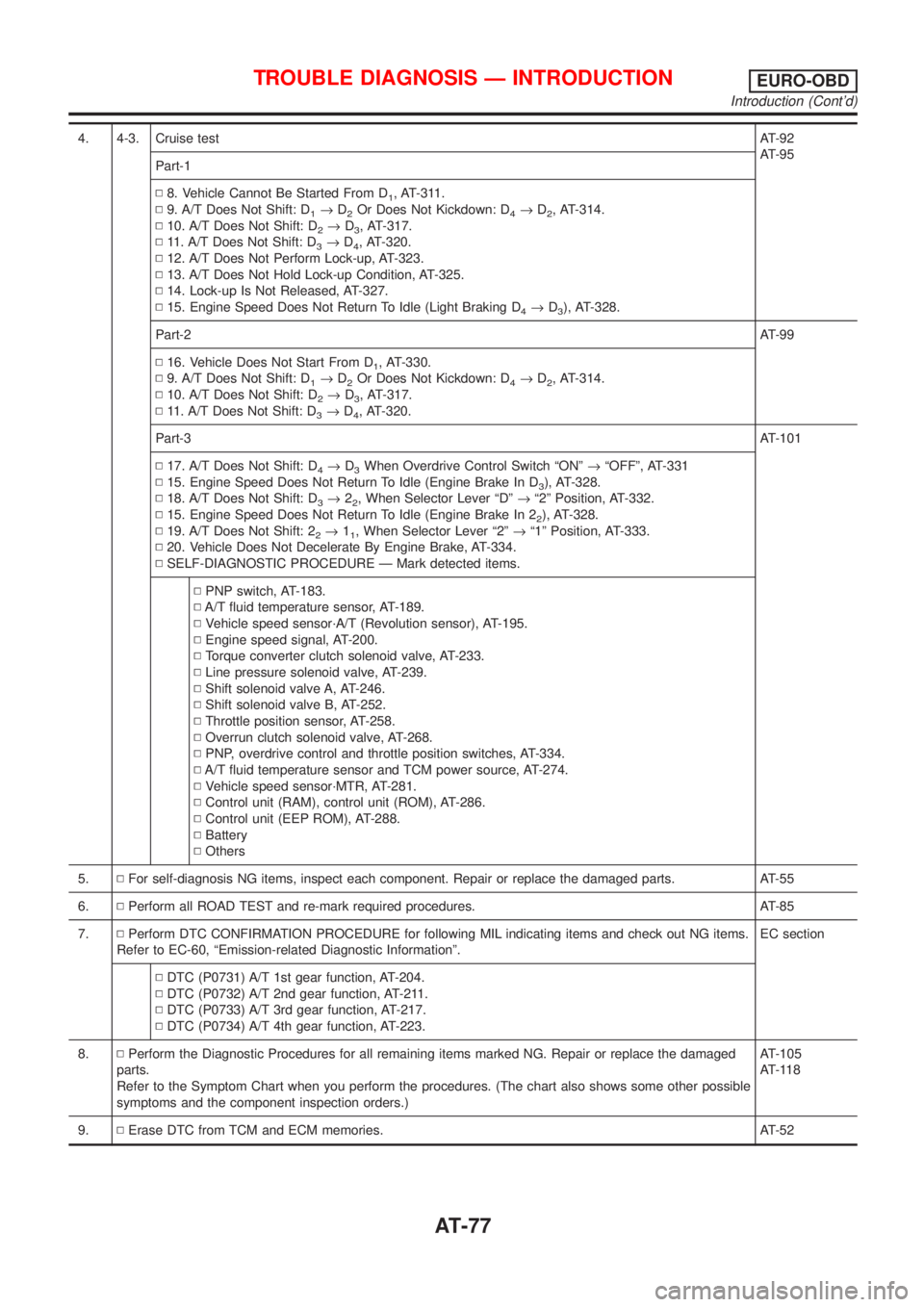
4. 4-3. Cruise testAT-92
AT-95
Part-1
N8. Vehicle Cannot Be Started From D
1, AT-311.
N9. A/T Does Not Shift: D
1®D2Or Does Not Kickdown: D4®D2, AT-314.
N10. A/T Does Not Shift: D
2®D3, AT-317.
N11. A/T Does Not Shift: D
3®D4, AT-320.
N12. A/T Does Not Perform Lock-up, AT-323.
N13. A/T Does Not Hold Lock-up Condition, AT-325.
N14. Lock-up Is Not Released, AT-327.
N15. Engine Speed Does Not Return To Idle (Light Braking D
4®D3), AT-328.
Part-2AT-99
N16. Vehicle Does Not Start From D
1, AT-330.
N9. A/T Does Not Shift: D
1®D2Or Does Not Kickdown: D4®D2, AT-314.
N10. A/T Does Not Shift: D
2®D3, AT-317.
N11. A/T Does Not Shift: D
3®D4, AT-320.
Part-3AT-101
N17. A/T Does Not Shift: D
4®D3When Overdrive Control Switch ªONº®ªOFFº, AT-331
N15. Engine Speed Does Not Return To Idle (Engine Brake In D
3), AT-328.
N18. A/T Does Not Shift: D
3®22, When Selector Lever ªDº®ª2º Position, AT-332.
N15. Engine Speed Does Not Return To Idle (Engine Brake In 2
2), AT-328.
N19. A/T Does Not Shift: 2
2®11, When Selector Lever ª2º®ª1º Position, AT-333.
N20. Vehicle Does Not Decelerate By Engine Brake, AT-334.
NSELF-DIAGNOSTIC PROCEDURE Ð Mark detected items.
NPNP switch, AT-183.
NA/T fluid temperature sensor, AT-189.
NVehicle speed sensor´A/T (Revolution sensor), AT-195.
NEngine speed signal, AT-200.
NTorque converter clutch solenoid valve, AT-233.
NLine pressure solenoid valve, AT-239.
NShift solenoid valve A, AT-246.
NShift solenoid valve B, AT-252.
NThrottle position sensor, AT-258.
NOverrun clutch solenoid valve, AT-268.
NPNP, overdrive control and throttle position switches, AT-334.
NA/T fluid temperature sensor and TCM power source, AT-274.
NVehicle speed sensor´MTR, AT-281.
NControl unit (RAM), control unit (ROM), AT-286.
NControl unit (EEP ROM), AT-288.
NBattery
NOthers
5.NFor self-diagnosis NG items, inspect each component. Repair or replace the damaged parts. AT-55
6.NPerform all ROAD TEST and re-mark required procedures. AT-85
7.NPerform DTC CONFIRMATION PROCEDURE for following MIL indicating items and check out NG items.
Refer to EC-60, ªEmission-related Diagnostic Informationº.EC section
NDTC (P0731) A/T 1st gear function, AT-204.
NDTC (P0732) A/T 2nd gear function, AT-211.
NDTC (P0733) A/T 3rd gear function, AT-217.
NDTC (P0734) A/T 4th gear function, AT-223.
8.NPerform the Diagnostic Procedures for all remaining items marked NG. Repair or replace the damaged
parts.
Refer to the Symptom Chart when you perform the procedures. (The chart also shows some other possible
symptoms and the component inspection orders.)AT-105
AT-118
9.NErase DTC from TCM and ECM memories. AT-52
TROUBLE DIAGNOSIS Ð INTRODUCTIONEURO-OBD
Introduction (Cont'd)
AT-77
Page 80 of 2898
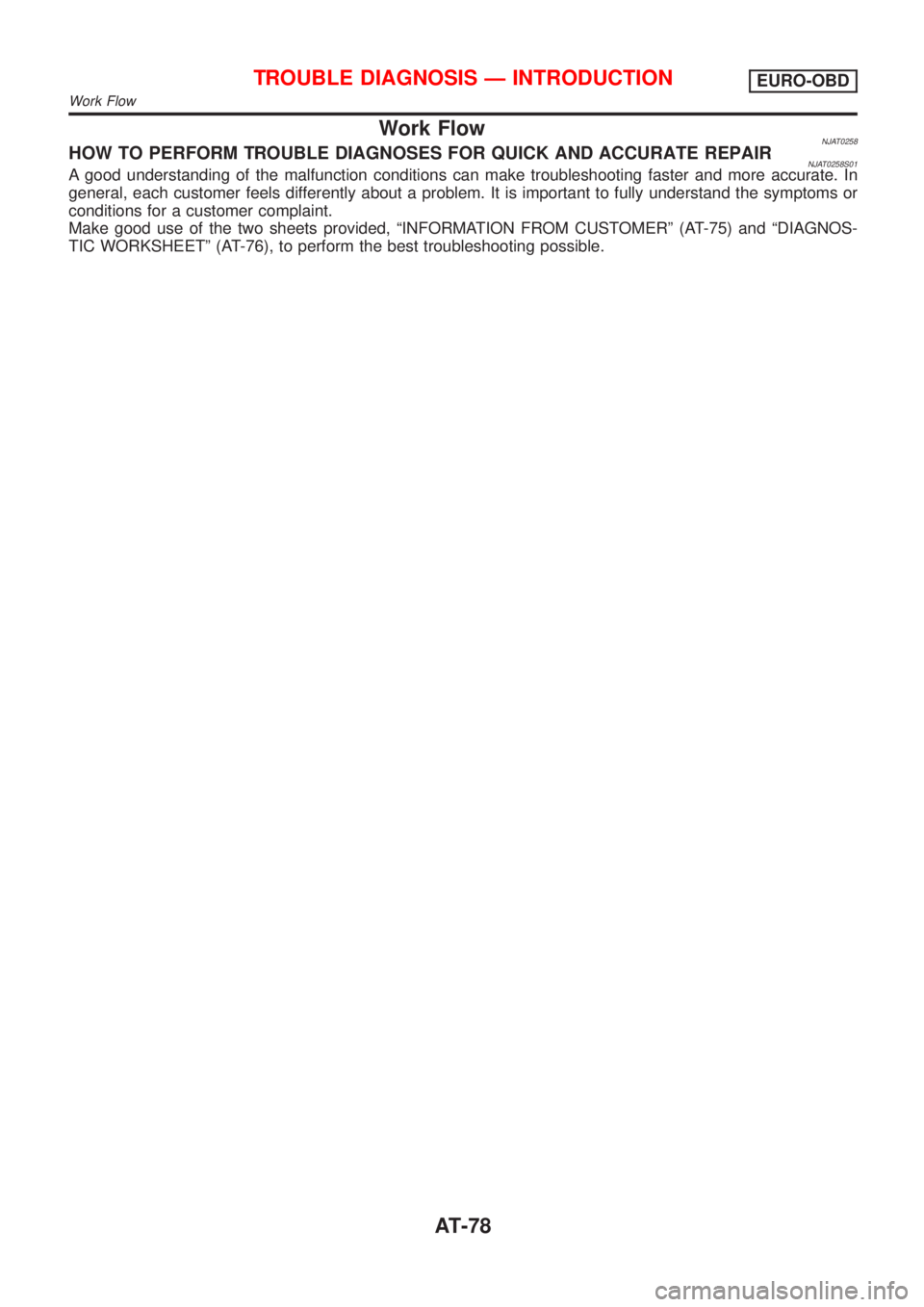
Work FlowNJAT0258HOW TO PERFORM TROUBLE DIAGNOSES FOR QUICK AND ACCURATE REPAIRNJAT0258S01A good understanding of the malfunction conditions can make troubleshooting faster and more accurate. In
general, each customer feels differently about a problem. It is important to fully understand the symptoms or
conditions for a customer complaint.
Make good use of the two sheets provided, ªINFORMATION FROM CUSTOMERº (AT-75) and ªDIAGNOS-
TIC WORKSHEETº (AT-76), to perform the best troubleshooting possible.
TROUBLE DIAGNOSIS Ð INTRODUCTIONEURO-OBD
Work Flow
AT-78